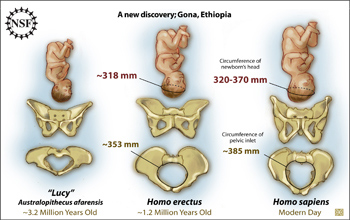All Images
News Release 08-203
Discovery Questions Intelligence of Human Ancestor
Pelvis dated to 1.2 million years ago shows our ancestors were born with bigger heads
This material is available primarily for archival purposes. Telephone numbers or other contact information may be out of date; please see current contact information at media contacts.

Three sets of pelvic bones (both a side view and top view) are shown, along with the approximate size of full-term fetus they could handle. On the left is the pelvis and baby of "Lucy", the Australopithecus afarensis from 3.2 million years ago. In the middle is the newly discovered pelvis of 1.2 million year old Homo erectus, and on the right is the pelvis and baby of a modern day female human being, or Homo sapiens.
Homo erectus was previously thought to produce babies with relatively small brain capacity. However the discovery of the pictured pelvis has shown that they were actually capable of birthing babies with a cranial circumference very close to the lower end of the range of our own species. The Homo erectus shown could have produced a baby with a cranial circumference of 318 mm, while modern day babies vary from 320 to 370 mm.
Credit: Credit: Zina Deretsky, National Science Foundation
Download the high-resolution JPG version of the image. (928 KB)
Use your mouse to right-click (Mac users may need to Ctrl-click) the link above and choose the option that will save the file or target to your computer.

The research appears in the November 14, 2008 issue of Science magazine.
Credit: Copyright 2008 AAAS
Download the high-resolution JPG version of the image. (373 KB)
Use your mouse to right-click (Mac users may need to Ctrl-click) the link above and choose the option that will save the file or target to your computer.


